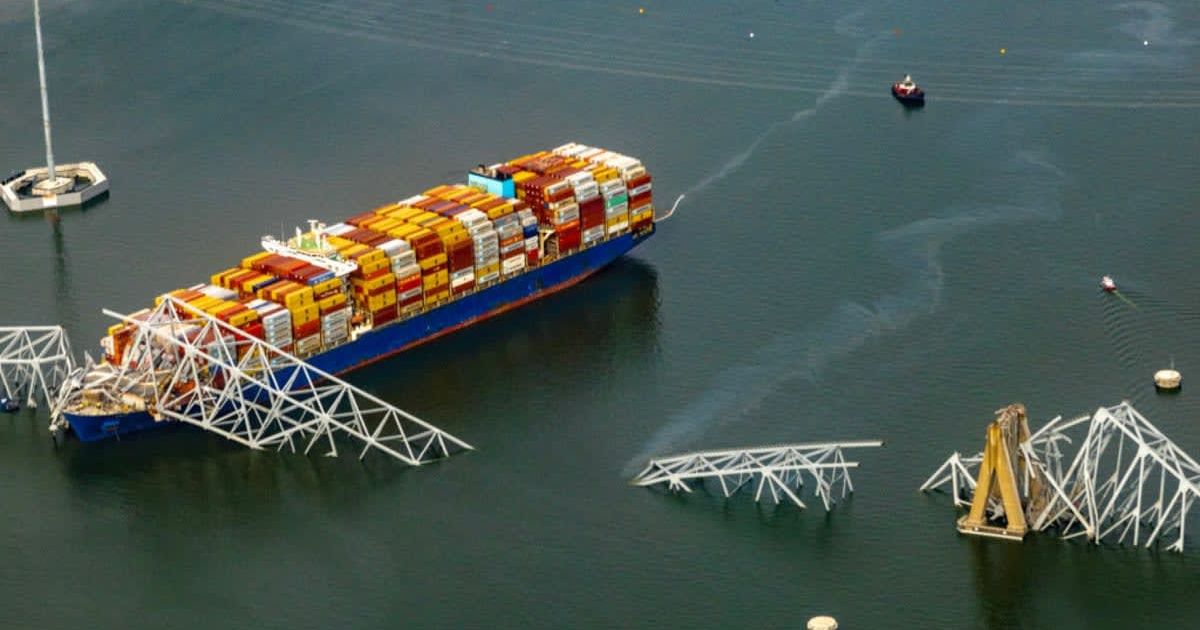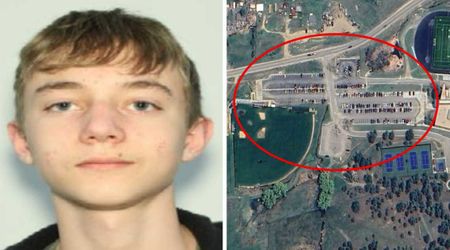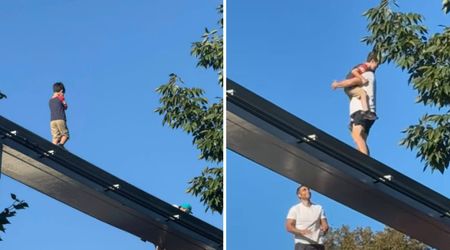Dali: Mega container ship that hit Baltimore bridge was involved in another collision at the Port of Antwerp, Belgium, in 2016

MARYLAND, BALTIMORE: The same vessel Dali that struck Baltimore's Francis Scott Key Bridge on Tuesday, March 26, demolishing it and plunging people and vehicles into the ocean, collided with a quay while leaving the Port of Antwerp, Belgium, in 2016.
Cargo ship Dali was detained following the 2016 Port of Antwerp crash
According to the Shipwreck Log, Dali which is a 948 ft cargo ship with a capacity of 10,000 containers was leaving the container terminal of Antwerp heading to Bremerhaven on July 11, 2016, when the crash occurred.
"The bow of the box ship swung around causing the the stern to scrap along the quay. The box ship sustained significant damage to several meters of its hull," according to Shipwreck Log.
There were no reports of injuries, but Dali was detained at Deurganckdok, Antwerp, after the incident.
The Antwerp quay crash was blamed on cargo ship Dali's pilot
According to the Vessel Finder, the weather at the time of the accident was good and caused by the "mistakes" of the Master and pilot on board.
It said apart from the damage to the stern, the transom was also significantly damaged. It also had some "breaches" near the waterline and needed repairs but remained afloat.
The cargo ship berth was also closed for significant damage with cargo handling operations closed due to safety reasons.
The vessel was built in 2015 by Hyundai Heavy Industries in South Korea. It was owned by the Greek company Oceanbulk Maritime but was chartered by Maersk Line at the time.
All 22 onboard cargo ship Dali were Indians during Port of Antwerp crash
The Maritime and Port Authority of Singapore (MPA) reported that Dali was registered in Singapore and had 22 crew on board.
Shipping company Maersk added that all were Indian, as per Guardian. But Maersk also stated that none of the onboard crew members belonged to their company.
The ship is believed to be operated by the chartered company Synergy Group.
The Port of Antwerp didn’t disclose the cause of the accident, but according to NBC said that “in case an incident happens, a ship can only leave the port after experts have determined that it can sail safely.”
A video from that incident shows the ship crashing into a wall at the port.
How did cargo ship Dali crash into the Baltimore Bridge?
Baltimore residents were woken up by a "loud boom" on March 26 morning with beds shaking as cargo ship Dali slammed into Francis Scott Key Bridge at 1.28 am.
With the lights on the ship going on and off before the collapse and no apparent maneuvers before it struck, the experts have suggested the ship had some "serious mechanical issues."
This might be an unpopular opinion, but I don’t see anything that would indicate the tragedy in Baltimore was some sort of terror attack.
— Clandestine (@WarClandestine) March 26, 2024
Strategically, what would it accomplish?
If they wanted to terrorize the US, they would have picked a different bridge, at a busier time.… pic.twitter.com/j9xi2LBDMh
“There is no worse feeling on a ship than when it goes silent,” Captain Morgan McManus, an instructor at SUNY Maritime College in New York who has worked on container ships told NBC.
According to a report, six workers from Brawner Builders are unaccounted for. The construction workers were pouring concrete to fix potholes on the roadway on the bridge.
Some of the construction workers who are missing are said to have welcomed babies within the last year.
Cargo ship Dali's 'mayday' call saved lives
However, James Wallace, chief of the Baltimore City Fire Department, said Dali sent out a 'mayday' call which helped them stop the flow of traffic on the bridge before the collision.
“We’re thankful that between the ‘mayday’ and collapse that we had officials who were able to—to begin the stop the flow of traffic so more cars were not up on the bridge,” the governor said.
Dashcam footage of driving over the Baltimore Bridge truly reveals the scale of what has collapsed, and collapsed so quickly and completely. pic.twitter.com/0RU9hMAsYN
— Guy Walters 🇺🇦 (@guywalters) March 26, 2024
He said two workers who’d been fixing potholes on the bridge, which is used by 31,000 vehicles per day were rescued from the frigid water.
One avoided injury, and the other was hospitalized with serious injuries, he detailed. That patient was discharged by Tuesday, March 26, afternoon, the University of Maryland Medical Center said in a statement.
The Internet has mixed reactions to the incident
The internet reacted with wild theories some terming it "catastrophic" and others couldn't believe it was possible in today with the sort of technology. Some also remarked on the fragility of the infrastructure.
"Horrible. It’s hard to believe that with today’s technology, this disaster could happen," one wrote on X.
Another commented, "In times of disaster, it's a stark reminder of the fragility of our infrastructure and the need for comprehensive safety measures. Let's strive for resilient, sustainable solutions to prevent such tragedies in the future."
One termed it, "Catastrophic!," and another said, "Prayers for those who were involved in this tragedy."
One more added, "I have been praying for all the victims!! It's so sad!," and another questioned, "Where were the tug boats? Was the harbor master on break?"
Horrible. It’s hard to believe that with today’s technology this disaster could happen.
— Donna Stauch (@donnastauch) March 26, 2024
In times of disaster, its a stark reminder of the fragility of our infrastructure and the need for comprehensive safety measures. Lets strive for resilient, sustainable solutions to prevent such tragedies in the future.
— Muhmmad Azhar (@AzharTheGreat) March 26, 2024
I have been praying for all the victims!! It's so sad!
— Karen McCray (@KarenMc47088902) March 26, 2024
Where were the tug boats? Was the harbor master on break?
— BossyMother (@BossyMother) March 26, 2024
This article contains remarks made on the Internet by individual people and organizations. MEAWW cannot confirm them independently and does not support claims or opinions being made online.










